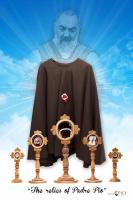First Class Relics Of St. Padre Pio To Visit The Diocese Of Evansville

First Class Relics of St. Pio of Pietrelcina – better known as St. Padre Pio – will visit St. Philip Parish in Posey County on May 1. The relics will be available for veneration from 9 a.m. CDT to 6:30 p.m. CDT on May 1. Bishop Joseph M. Siegel will celebrate Mass at 7 p.m. CDT to conclude the day.
The Saint Pio Foundation, which is sponsoring the tour, will provide books and items related to Padre Pio in the narthex of the Church.
The relics of Saint Pio available for public veneration will include Saint Pio's glove; Saint Pio's crusts of the Stigmata wounds; Cotton gauze with Saint Pio's blood stains; a lock of Saint Pio's hair; Saint Pio's mantle; and Saint Pio's handkerchief , soaked with his sweat from hours before he died.
The relics are touring archdioceses and dioceses in the U.S. this year from April 15 to June 15, and from Sept. 15 to Nov. 15. The relics also will be touring in the Dominican Republic and Canada. This 2019 tour follows tours in 2017 and 2018 that made headlines across the country and attracted an estimated 500,000 faithful. In addition, some of the most important secular media covered this event, including FOX News, NBC, The Wall Street Journal, The New York Times and others.
About St. Pio
St. Pio was born on May 25, 1887, in Pietrelcina, Italy, and baptized Francesco Forgione. He first expressed his desire for the priesthood at age 10. In order to pay for the preparatory education, his father, Grazio Forgione, emigrated to the United States in 1899, where he worked for several years.
The future saint entered the Capuchin order at age 15, taking the name Pio. He was ordained a priest in 1910 at the age of 23. During his lifetime, Padre Pio was known as a mystic with miraculous powers of healing and knowledge, and he bore the stigmata. Stigmata is the term the Catholic Church uses to describe the wounds an individual receives that correspond to the crucifixion wounds of Jesus Christ. They can appear on the forehead, hands, wrists and feet.
Padre Pio’s stigmata emerged during World War I after Pope Benedict XV asked Christians to pray for an end to the conflict. Padre Pio had a vision in which Christ pierced his side. A few weeks later, on Sept. 20, 1918, Jesus again appeared to him, and he received the full stigmata. It remained with him until his death on Sept. 23, 1968.
Several credible incidents of bilocation – where a person appears fully and interacts with people in two places, often great distances apart, at the same time – are credited to Padre Pio.
Pope John Paul II canonized him in 2002.
About the relics
In the Catholic Church, First Class Relics are physical objects associated with a saint or candidate for sainthood – part of the person’s body or something with which he or she was in contact. Relics are not worshiped but treated with religious respect. Touching or praying in the presence of such an object helps a faithful individual focus on the saint’s life and virtues so that through the saint’s prayer or intercession before God, the individual will be drawn closer to God.
About the St. Pio Foundation
The Saint Pio Foundation is a premier national charitable organization that promotes awareness of Saint Pio and his mission by working with institutions and individuals who share the same vision to serve “those in need of relief of suffering.” Funds raised by the Saint Pio Foundation are used to provide grants to American Catholic healthcare, educational, social, religious and cultural partner organizations. More information about Saint Pio Foundation can be found at http://www.saintpiofoundation.org.




